By Leen Randell
Updated: Jul 04, 2024
10 Best Herbal Decoctions For Diverticulitis
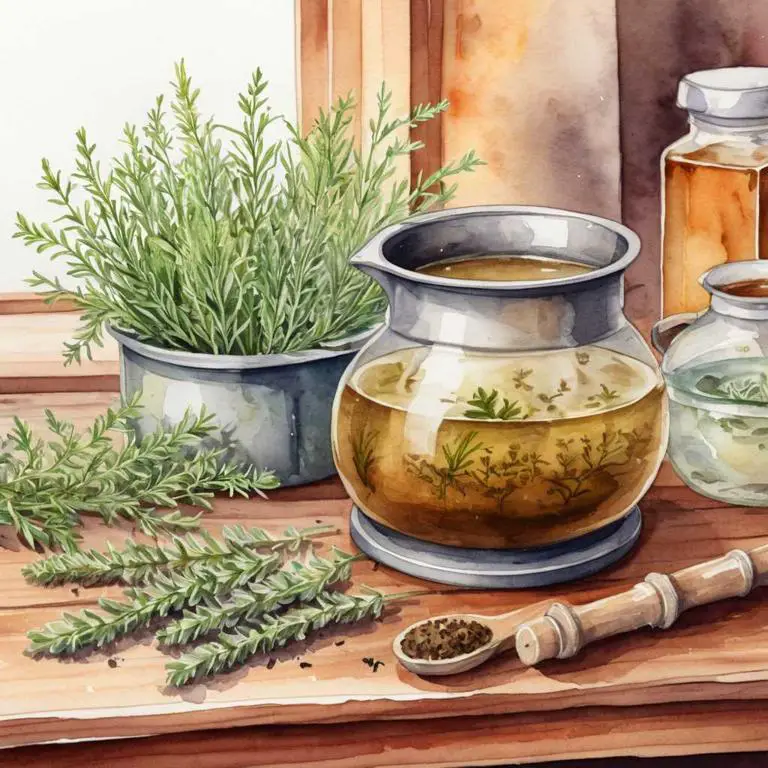
Herbal decoctions for diverticulitis are a natural remedy that helps alleviate symptoms and prevent flare-ups by soothing inflammation, reducing pain, and promoting digestive health.
These decoctions are created by steeping herbs like turmeric, ginger, and dandelion root in hot water to release their active compounds. By incorporating herbal decoctions into daily routines, individuals with diverticulitis can reduce discomfort, improve digestion, and enhance overall well-being.
For instance, a warm cup of turmeric tea before bed can promote relaxation and alleviate morning stiffness, while a ginger and dandelion root decoction during meals can stimulate digestive enzymes and prevent bloating.
The following article describes in detail the most important decoctions for diverticulitis, including medicinal properties, parts of herbs to use, and recipes for preparations.
- 1. Curcuma longa
- 2. Althaea officinalis
- 3. Glycyrrhiza glabra
- 4. Taraxacum officinale
- 5. Ulmus rubra
- 6. Hydrastis canadensis
- 7. Zingiber officinale
- 8. Mentha x piperita
- 9. Foeniculum vulgare
- 10. Matricaria chamomilla
- What is the best combination of herbal decoctions to use for diverticulitis?
- What ailments similar to diverticulitis are treated with herbal decoctions?
1. Curcuma longa
Turmeric decoctions helps with diverticulitis because of its potent anti-inflammatory and antioxidant properties.
The curcumin present in turmeric has been shown to reduce inflammation and oxidative stress, which are key factors in the development of diverticulitis. By reducing inflammation, turmeric decoctions can help alleviate symptoms such as abdominal pain, bloating, and discomfort. Additionally, turmeric's antimicrobial properties may help prevent bacterial overgrowth in the gut, a common trigger for diverticulitis episodes.
As a result, incorporating turmeric decoctions into one's daily routine may provide relief and promote overall digestive health.
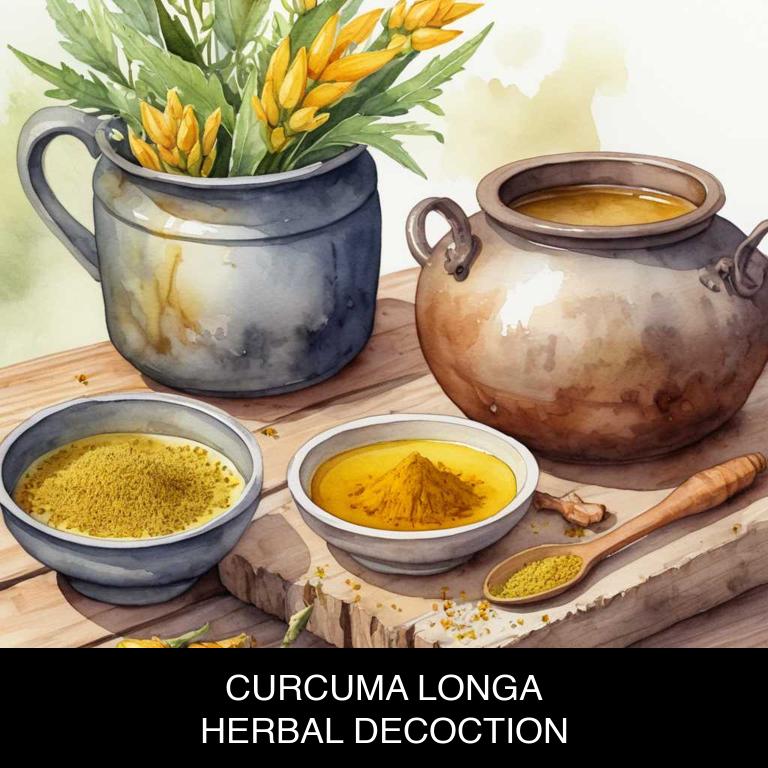
Medicinal Constituents
The list below shows the primary medicinal constituents in Curcuma longa decoctions that help with diverticulitis.
- Curcumin: A potent anti-inflammatory polyphenol that helps reduce inflammation and oxidative stress in the gut, which are key contributors to diverticulitis.
- Demethoxycurcumin: A curcuminoid that has been shown to have potent anti-inflammatory and antioxidant properties, which can help alleviate symptoms of diverticulitis and promote healing in the gut.
- Bisdemethoxycurcumin: A curcuminoid that has been found to have strong anti-inflammatory and antioxidant activities, which can help reduce inflammation, improve gut barrier function, and prevent complications associated with diverticulitis.
Parts Used
The list below shows the primary parts of turmeric used to make decoctions for diverticulitis.
- Rhyzomes: They are used due to their high content of curcumin, a potent anti-inflammatory compound that helps reduce inflammation and promote healing in the digestive tract.
- Roots: They contain bioactive compounds that have anti-inflammatory and antioxidant properties, which help alleviate symptoms of diverticulitis such as pain, swelling, and digestive discomfort.
- Leaves: They are used due to their ability to reduce inflammation and promote wound healing, which can help alleviate symptoms of diverticulitis and support the recovery process.
Quick Recipe
The following recipe gives a procedure to make a basic turmeric for diverticulitis.
- Harvest 1 to 2 pounds of fresh or 1 to 2 cups of dried curcuma longa rhizomes with clean scissors.
- Dry the harvested rhizomes in a warm place for 1 to 2 weeks to remove moisture completely.
- Grind 1 to 2 teaspoons of dried rhizomes into a fine powder using a spice grinder.
- Combine 1 cup of water and 1 to 2 teaspoons of ground rhizomes in a saucepan.
- Simmer the mixture over low heat for 10 to 15 minutes or until the liquid reduces to half.
2. Althaea officinalis
Marshmallow decoctions helps with diverticulitis because it soothes and protects the mucous membranes lining the digestive tract, reducing inflammation and discomfort.
The mucilage in marshmallow root forms a gel-like barrier that coats and shields the gut, preventing irritation from food and stool. Additionally, its anti-inflammatory properties help to calm the intestine, reducing spasms and pain associated with diverticulitis.
This natural remedy can provide relief for patients suffering from this often debilitating condition, promoting a sense of comfort and well-being.
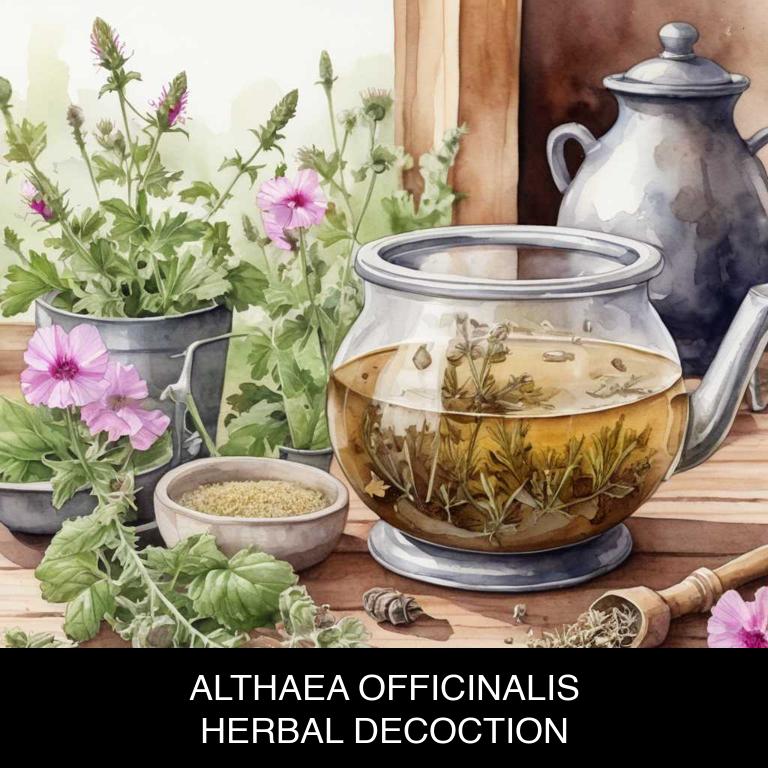
Medicinal Constituents
The list below shows the primary medicinal constituents in Althaea officinalis decoctions that help with diverticulitis.
- Polysaccharides: These complex carbohydrates have anti-inflammatory properties, which can help reduce inflammation and alleviate symptoms associated with diverticulitis.
- Phenolic acids: Gallic acid has been shown to possess anti-inflammatory and antioxidant properties, which can help mitigate oxidative stress and inflammation in the gastrointestinal tract, contributing to the management of diverticulitis.
- Mucilages: Pectins, a type of mucilage, can form a protective barrier on the mucous membranes, reducing inflammation and irritation, and promoting the healing of the gut lining, which can aid in the recovery from diverticulitis.
Parts Used
The list below shows the primary parts of marshmallow used to make decoctions for diverticulitis.
- Roots: They are commonly used due to their high mucilage content, which helps soothe and protect the digestive tract.
- Leaves: Leaves are used for their anti-inflammatory properties, which aid in reducing inflammation and promoting healing in the digestive system.
- Stems: Stems are also used for their mucilage content and are often combined with other parts to create a more effective decoction for treating diverticulitis.
Quick Recipe
The following recipe gives a procedure to make a basic marshmallow for diverticulitis.
- Harvest 30-40 grams of dried althaea officinalis root or 60-80 grams of fresh root.
- Rinse the dried or fresh root in cold water to remove any impurities or debris.
- Chop the root into smaller pieces to increase its surface area for infusion.
- Steep 1-2 teaspoons of chopped root in 250 milliliters of boiling water for 5-10 minutes.
- Strain the liquid from the root pieces and discard the solids to obtain the decoction.
3. Glycyrrhiza glabra
Licorice decoctions helps with diverticulitis because it has anti-inflammatory properties that can reduce swelling and pain in the digestive tract.
The herb's active compounds, such as glycyrrhizin and licoricidin, have been shown to soothe inflamed mucous membranes and promote healing of damaged tissues.
Additionally, licorice decoctions may help to improve digestion and reduce inflammation by increasing the production of protective mucus in the intestines, thereby helping to alleviate symptoms of diverticulitis such as abdominal pain, bloating, and changes in bowel movements.

Medicinal Constituents
The list below shows the primary medicinal constituents in Glycyrrhiza glabra decoctions that help with diverticulitis.
- Glycyrrhizin: A triterpenoid saponin that has anti-inflammatory properties, which may help reduce inflammation and alleviate symptoms associated with diverticulitis.
- Liquiritigenin: A flavonoid compound with anti-inflammatory and antioxidant properties, which may help protect the digestive tract from oxidative stress and reduce inflammation in diverticulitis.
- Isoliquiritigenin: A flavonoid compound with anti-inflammatory and antimicrobial properties, which may help reduce inflammation and prevent infections that can exacerbate diverticulitis.
Parts Used
The list below shows the primary parts of licorice used to make decoctions for diverticulitis.
- Roots: The roots are widely used due to their rich content of glycyrrhizin, a compound that has anti-inflammatory properties which can help alleviate symptoms of diverticulitis.
- Barks: The barks are used to create decoctions that can help soothe and calm the digestive system, reducing inflammation and promoting healing in the digestive tract.
- Leaves: The leaves of Glycyrrhiza glabra are used to make decoctions that can help reduce inflammation and alleviate symptoms such as abdominal pain and diarrhea associated with diverticulitis.
Quick Recipe
The following recipe gives a procedure to make a basic licorice for diverticulitis.
- Harvest fresh roots of glycyrrhiza glabra in late summer or early fall when the plant is in full maturity.
- Wash the harvested roots with clean water to remove dirt and debris then gently scrub them.
- Chop 3 to 6 grams of the cleaned roots into small pieces for decoction.
- Boil 250 milliliters of water in a saucepan then add the chopped roots and continue boiling for 10 to 15 minutes.
- Strain the decoction using a cheesecloth or a fine-mesh sieve into a clean container to remove the roots.
4. Taraxacum officinale
Dandelion decoctions helps with diverticulitis because of its anti-inflammatory and antioxidant properties.
The decoction's flavonoids, particularly kaempferol and quercetin, help reduce inflammation and alleviate symptoms such as abdominal pain and cramping. Additionally, dandelion's high fiber content supports regular bowel movements, which can help prevent constipation, a common exacerbating factor for diverticulitis.
By soothing the digestive tract and promoting natural detoxification, dandelion decoctions may help manage diverticulitis symptoms and promote overall gut health.

Medicinal Constituents
The list below shows the primary medicinal constituents in Taraxacum officinale decoctions that help with diverticulitis.
- Flavonoids: They help with diverticulitis by reducing inflammation and oxidative stress in the digestive tract, which can exacerbate the condition.
- Saponins: They have antimicrobial properties, which can help prevent infections that may contribute to diverticulitis and aid in the healing process.
- Polysaccharides: They have anti-inflammatory and immunomodulatory effects, which can help reduce inflammation, promote healing, and regulate the immune response in diverticulitis patients.
Parts Used
The list below shows the primary parts of dandelion used to make decoctions for diverticulitis.
- Leaves: Used for their anti-inflammatory properties to reduce swelling and ease symptoms associated with diverticulitis.
- Roots: Utilized for their potential to stimulate digestion and alleviate digestive issues, such as diverticulitis.
- Seeds: Employed for their possible anti-inflammatory and antimicrobial properties to help combat bacterial infections and reduce inflammation in diverticulitis cases.
Quick Recipe
The following recipe gives a procedure to make a basic dandelion for diverticulitis.
- Harvest 1-2 bunches of fresh taraxacum officinale leaves and roots in the early morning.
- Chop the harvested taraxacum officinale into small pieces using a sharp knife or herb cutter.
- Combine 2 teaspoons of chopped taraxacum officinale with 1 liter of boiling water in a heat-resistant container.
- Steep the taraxacum officinale mixture for 5-7 minutes in a covered container to allow flavors to infuse.
- Strain the decoction through a fine-mesh sieve or cheesecloth into a clean container to remove solids.
5. Ulmus rubra
Slippery elm decoctions helps with diverticulitis because its mucilaginous properties soothe and protect the digestive tract lining, reducing inflammation and discomfort.
The decoction's anti-inflammatory compounds, such as flavonoids and phenolic acids, also help to reduce swelling in the affected area, allowing for easier passage of stool and relieving symptoms like abdominal pain, bloating, and cramping.
Additionally, slippery elm's demulcent properties create a protective barrier that shields the gut from irritation, promoting healing and reducing inflammation.
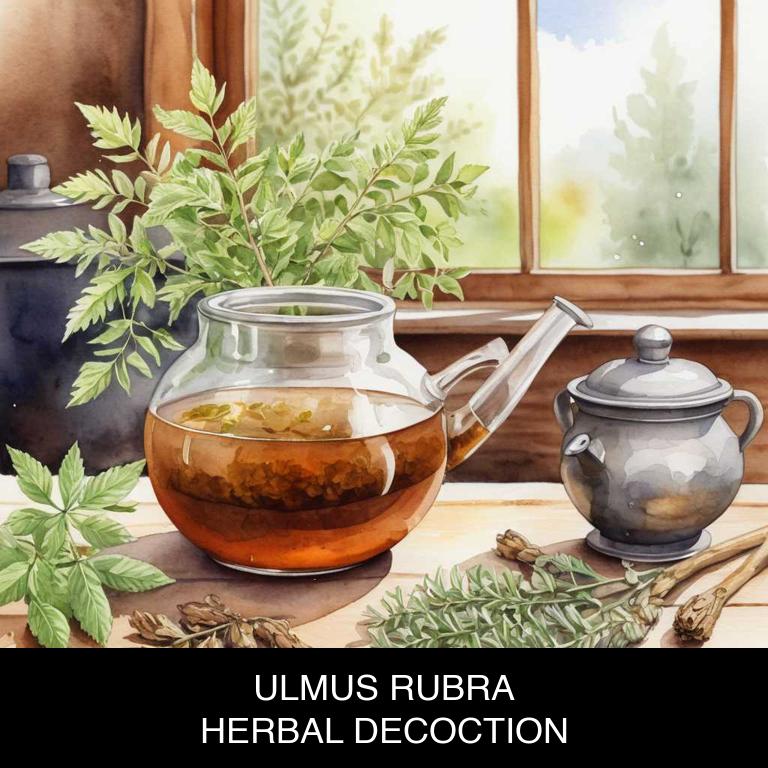
Medicinal Constituents
The list below shows the primary medicinal constituents in Ulmus rubra decoctions that help with diverticulitis.
- Phenolic acids: These compounds may help reduce inflammation in the digestive tract and prevent the formation of diverticula by inhibiting the growth of bacteria that contribute to the condition.
- Flavonoids: Flavonoids, such as quercetin and kaempferol, may exhibit anti-inflammatory and antioxidant properties, which can help soothe the digestive tract, reduce inflammation, and promote healing in the affected area.
- Tannins: Tannins in Ulmus rubra may help reduce inflammation and prevent bacterial overgrowth in the digestive tract by creating an environment that is unfavorable to the growth of pathogenic bacteria.
Parts Used
The list below shows the primary parts of slippery elm used to make decoctions for diverticulitis.
- Barks: Ulmus rubra barks are used to make decoctions due to their anti-inflammatory properties that help alleviate symptoms of diverticulitis.
- Roots: Ulmus rubra roots are used for their potential to reduce inflammation and improve digestive health, which can help in managing diverticulitis.
- Leaves: Ulmus rubra leaves are used in decoctions due to their antioxidant properties that may help soothe the digestive tract and reduce inflammation associated with diverticulitis.
Quick Recipe
The following recipe gives a procedure to make a basic slippery elm for diverticulitis.
- Harvest 1-2 pounds of fresh ulmus rubra roots in late fall or early spring.
- Chop the roots into small pieces and dry them in a low-temperature oven at 150 degrees for 2 hours.
- Combine 1 ounce of dried roots with 2 cups of boiling water in a saucepan.
- Reduce heat to a simmer and let the mixture steep for 10-15 minutes.
- Strain the liquid through a cheesecloth and discard the solids.
6. Hydrastis canadensis
Goldenseal decoctions helps with diverticulitis because of its potent anti-inflammatory and antimicrobial properties.
The alkaloids present in goldenseal, such as berberine, have been shown to reduce inflammation and swelling in the digestive tract, thereby alleviating symptoms associated with diverticulitis. Additionally, goldenseal's antimicrobial properties help combat bacterial overgrowth in the gut, which is often linked to this condition.
By reducing inflammation and eliminating pathogens, goldenseal decoctions may help alleviate symptoms of diverticulitis and promote healing in the digestive tract.
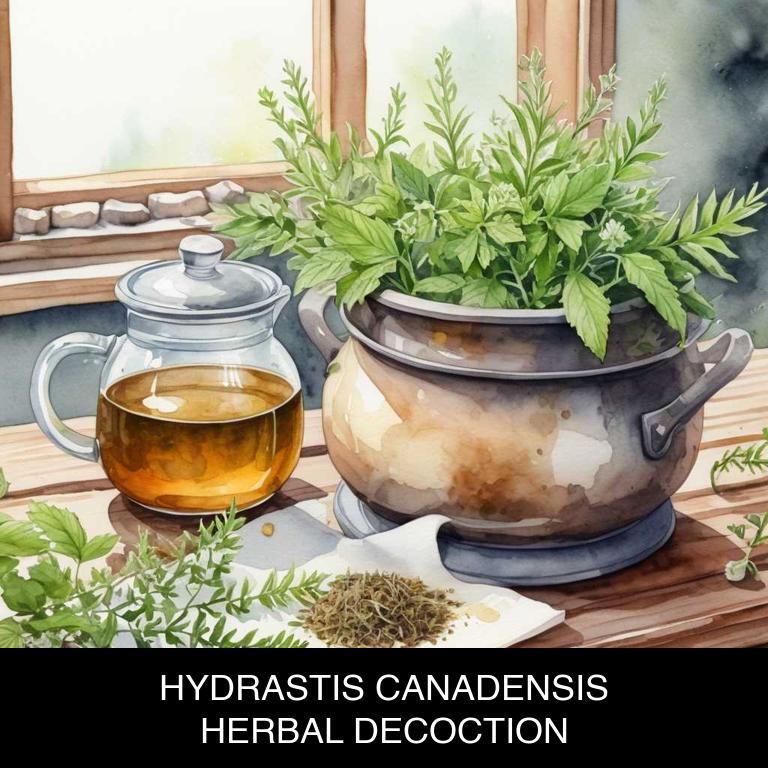
Medicinal Constituents
The list below shows the primary medicinal constituents in Hydrastis canadensis decoctions that help with diverticulitis.
- Berberine: This isoquinoline alkaloid has antimicrobial and anti-inflammatory properties, which can help reduce inflammation and prevent infections that may exacerbate diverticulitis.
- Hydrastine: This isoquinoline alkaloid has antimicrobial and antiseptic properties, which can help combat bacterial overgrowth and prevent the spread of infection in the digestive tract, thereby aiding in the treatment of diverticulitis.
- Berbamine: This benzylisoquinoline alkaloid has anti-inflammatory and antioxidant properties, which can help reduce inflammation and oxidative stress in the digestive tract, thus alleviating symptoms of diverticulitis.
Parts Used
The list below shows the primary parts of goldenseal used to make decoctions for diverticulitis.
- Roots: They are the primary source of hydrastine and berberine, which exhibit anti-inflammatory properties that can help alleviate diverticulitis symptoms.
- Barks: The bark of the plant is also a rich source of berberine, which has antimicrobial and anti-inflammatory properties that can aid in treating diverticulitis.
- Leaves: The leaves of Hydrastis canadensis are less commonly used but still contain berberine and other compounds that can help reduce inflammation and alleviate symptoms associated with diverticulitis.
Quick Recipe
The following recipe gives a procedure to make a basic goldenseal for diverticulitis.
- Harvest fresh or dried roots of hydrastis canadensis in autumn or early spring when the plant is dormant.
- Clean the roots thoroughly with cold water to remove dirt and debris from the harvest process.
- Chop the roots into smaller pieces to increase their surface area for decoction.
- Combine 1-2 teaspoons of chopped roots with 1 quart of boiling water in a non-reactive pot.
- Simmer the mixture for 10-15 minutes to release the active compounds from the roots into the water.
7. Zingiber officinale
Ginger decoctions helps with diverticulitis because it has potent anti-inflammatory properties that help reduce swelling and alleviate pain in the digestive tract.
The antioxidants present in ginger also work to neutralize free radicals that can exacerbate inflammation, promoting a healthy gut environment. Additionally, ginger's natural digestive enzymes help stimulate bowel movements, reducing constipation and straining that can contribute to diverticulitis flare-ups.
By soothing the digestive system, ginger decoctions provide relief from the symptoms of diverticulitis, promoting overall digestive health and well-being.
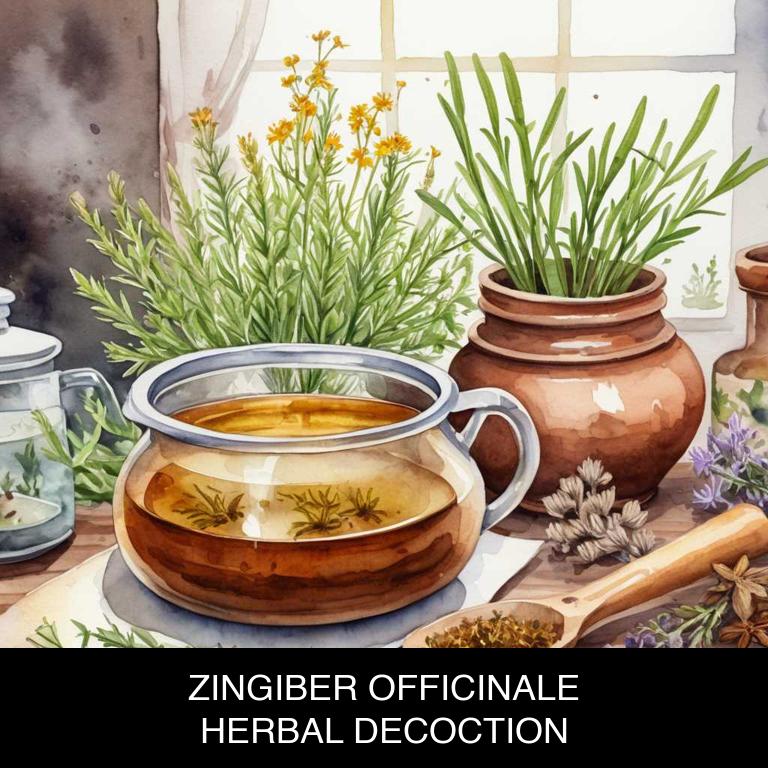
Medicinal Constituents
The list below shows the primary medicinal constituents in Zingiber officinale decoctions that help with diverticulitis.
- Gingerols: These phenolic compounds possess anti-inflammatory properties, which can help reduce inflammation and alleviate symptoms associated with diverticulitis.
- Shogaols: As a class of gingerols, shogaols have been shown to have potent anti-inflammatory and antioxidant effects, which may help mitigate oxidative stress and inflammation in diverticulitis patients.
- 6-gingerol: This specific gingerol has been found to have antimicrobial properties, which can help prevent bacterial overgrowth in the gut, a contributing factor to diverticulitis.
Parts Used
The list below shows the primary parts of ginger used to make decoctions for diverticulitis.
- Rhyzomes: Used for their anti-inflammatory properties to help alleviate symptoms of diverticulitis.
- Roots: Utilized for their digestive benefits to soothe the digestive tract and reduce inflammation associated with diverticulitis.
- Stems: Employed for their antimicrobial properties to help combat infections that may contribute to diverticulitis.
Quick Recipe
The following recipe gives a procedure to make a basic ginger for diverticulitis.
- Harvest 2-3 fresh or dried roots of zingiber officinale for decoction preparation.
- Chop 3-4 grams of the harvested roots into small pieces to enhance extraction efficiency.
- Combine the chopped roots with 500 milliliters of water in a saucepan.
- Boil the mixture over high heat for 5-7 minutes to initiate extraction process.
- Strain the decoction through a cheesecloth or fine mesh into a separate container.
8. Mentha x piperita
Peppermint decoctions helps with diverticulitis because of its natural anti-inflammatory properties.
The menthol present in peppermint oil soothes the digestive tract, reducing inflammation and discomfort associated with diverticulitis. Additionally, peppermint's carminative effects help to ease symptoms such as bloating and flatulence, allowing for better digestion and relief from abdominal pain.
By calming the muscles of the intestines, peppermint decoctions can also help to reduce spasms and cramping often experienced during an episode of diverticulitis.
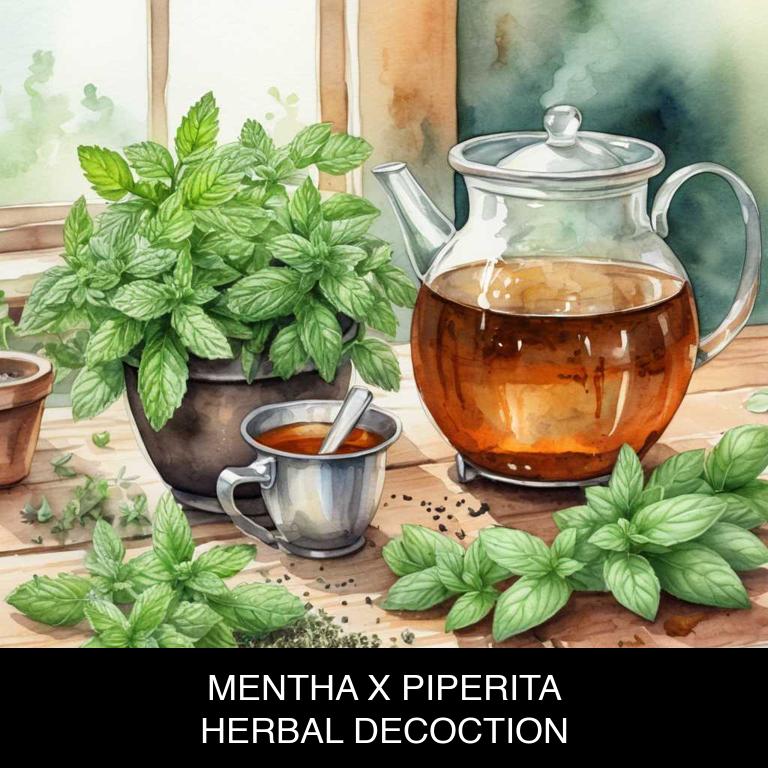
Medicinal Constituents
The list below shows the primary medicinal constituents in Mentha x piperita decoctions that help with diverticulitis.
- Menthol: Menthol acts as an anti-inflammatory agent, helping to reduce inflammation and alleviate symptoms associated with diverticulitis.
- Caryophyllene oxide: Caryophyllene oxide has been shown to possess anti-inflammatory and antimicrobial properties, which can help combat bacterial infections and reduce inflammation in diverticulitis cases.
- Rosmarinic acid: Rosmarinic acid exhibits potent antioxidant and anti-inflammatory properties, which can help mitigate oxidative stress and inflammation in the digestive tract, promoting healing and reducing symptoms of diverticulitis.
Parts Used
The list below shows the primary parts of peppermint used to make decoctions for diverticulitis.
- Leaves: They are used for their anti-inflammatory and antibacterial properties to soothe and calm the digestive system.
- Roots: They contain menthol and other compounds that help to reduce inflammation and ease digestive discomfort associated with diverticulitis.
- Rhyzomes: They are used to stimulate digestion, reduce spasms, and alleviate symptoms such as bloating and abdominal pain.
Quick Recipe
The following recipe gives a procedure to make a basic peppermint for diverticulitis.
- Measure 1-2 teaspoons of dried mentha x piperita leaves per 8 ounces of water.
- Combine the measured dried leaves with water in a saucepan and bring to a boil.
- Reduce heat to a simmer and let the mixture steep for 5-10 minutes.
- Strain the liquid through a cheesecloth or fine-mesh sieve into a cup or jug.
- Store the cooled decoction in an airtight container in the refrigerator for up to 3 days.
9. Foeniculum vulgare
Fennel decoctions helps with diverticulitis because of its natural anti-inflammatory properties.
The flavonoids present in fennel, such as quercetin and kaempferol, have been shown to reduce inflammation in the digestive tract, alleviating symptoms associated with diverticulitis. Additionally, fennel's carminative properties help to soothe the gut, reducing spasms and cramps that can exacerbate the condition.
By promoting relaxation of the intestinal muscles and improving digestion, fennel decoctions may help reduce the severity and frequency of diverticulitis episodes.
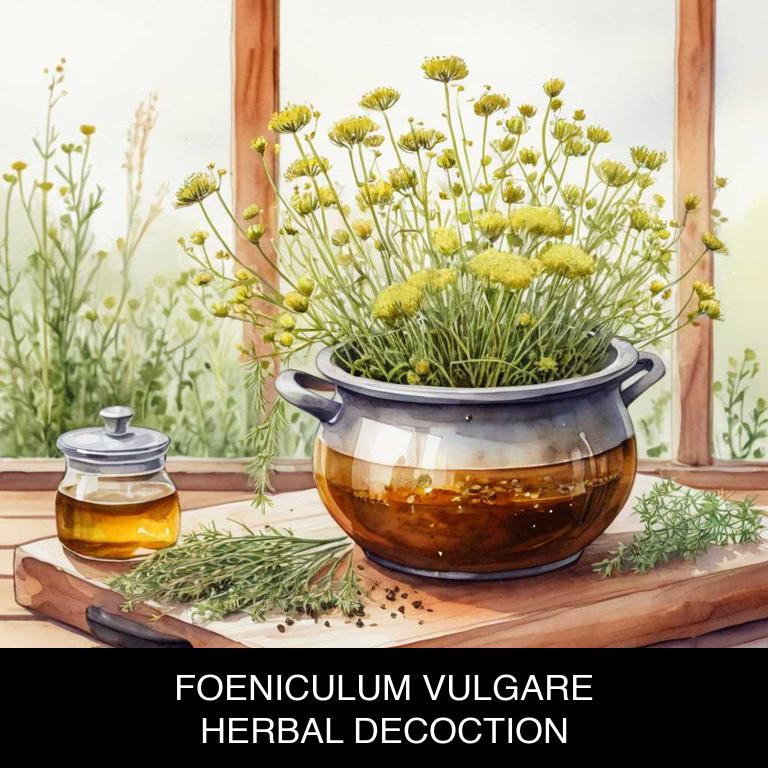
Medicinal Constituents
The list below shows the primary medicinal constituents in Foeniculum vulgare decoctions that help with diverticulitis.
- Anethole: Helps reduce inflammation and alleviate pain associated with diverticulitis by acting as an anti-inflammatory and analgesic compound.
- Lignans: Exerts antimicrobial properties, which may help prevent bacterial infections that can worsen diverticulitis symptoms.
- Flavonoids: Possess antioxidant properties, which can help reduce oxidative stress and inflammation in the digestive tract, potentially alleviating diverticulitis symptoms.
Parts Used
The list below shows the primary parts of fennel used to make decoctions for diverticulitis.
- Leaves: They are rich in antioxidants and volatile oils that help reduce inflammation and alleviate symptoms associated with diverticulitis.
- Seeds: The seeds contain a compound called anethole, which has anti-inflammatory and antimicrobial properties that can help soothe and heal the digestive tract.
- Roots: They are a good source of fiber and antioxidants that can help regulate bowel movements, reduce inflammation, and promote overall digestive health.
Quick Recipe
The following recipe gives a procedure to make a basic fennel for diverticulitis.
- Gather 2-3 teaspoons of dried foeniculum vulgare roots and leaves for the decoction.
- Combine the dried foeniculum vulgare with 1 liter of boiling water for 5-7 minutes.
- Reduce the heat to a simmer and continue cooking for an additional 10-15 minutes.
- Strain the decoction through a cheesecloth or a fine-mesh sieve into a clean container.
- Allow the decoction to cool and store it in the refrigerator for up to 3 days.
10. Matricaria chamomilla
Chamomile decoctions helps with diverticulitis because its soothing and anti-inflammatory properties can reduce inflammation and alleviate symptoms such as abdominal pain, cramping, and bloating.
The antioxidants and flavonoids present in chamomile also help to heal damaged intestinal tissues and reduce inflammation in the diverticula, promoting a healthy gut environment.
Additionally, chamomile's calming effects can help to relax the digestive system, reducing spasms and discomfort associated with diverticulitis.
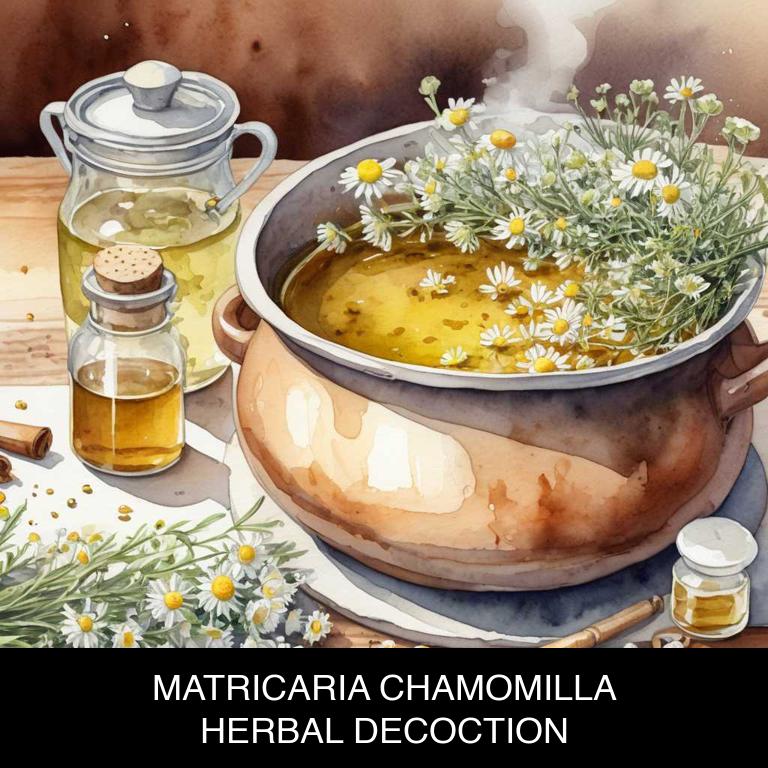
Medicinal Constituents
The list below shows the primary medicinal constituents in Matricaria chamomilla decoctions that help with diverticulitis.
- Apigenin: This flavonoid has anti-inflammatory and antioxidant properties, which can help reduce inflammation and oxidative stress associated with diverticulitis.
- Luteolin: This flavonoid has antimicrobial and anti-inflammatory properties, which can help prevent infections and reduce inflammation in the digestive tract, potentially alleviating symptoms of diverticulitis.
- Α-bisabolol: This sesquiterpene has anti-inflammatory and soothing properties, which can help reduce inflammation and promote healing in the digestive tract, potentially alleviating symptoms of diverticulitis.
Parts Used
The list below shows the primary parts of chamomile used to make decoctions for diverticulitis.
- Flowers: Used for their anti-inflammatory and soothing properties to calm digestive issues.
- Leaves: Utilized for their bitter properties to stimulate digestion and alleviate symptoms of diverticulitis.
- Seeds: Employed for their carminative and antispasmodic effects to reduce inflammation and alleviate abdominal pain.
Quick Recipe
The following recipe gives a procedure to make a basic chamomile for diverticulitis.
- Harvest 30 grams of dried matricaria chamomilla flowers from a clean and sterile environment.
- Steep the dried flowers in 1 liter of boiling water for 5 to 10 minutes.
- Strain the decoction through a fine-mesh sieve or cheesecloth to remove any solids.
- Discard the solids and store the liquid decoction in a glass container in the refrigerator.
- Use the decoction within 24 hours or freeze it for later use.
What is the best combination of herbal decoctions to use for diverticulitis?
The best combination of herbal decoctions that help with diverticulitis is a blend of Dandelion root, Marshmallow root, and Slippery elm.
Dandelion root aids in digestion and reduces inflammation, while Marshmallow root soothes the digestive tract and protects it from irritation. Slippery elm, rich in mucilage, forms a protective barrier on the lining of the digestive tract, reducing inflammation and promoting healing.
This combination can help alleviate symptoms of diverticulitis, such as abdominal pain and digestive discomfort.
What ailments similar to diverticulitis are treated with herbal decoctions?
Ailments similar to diverticulitis/decoctions.html">diverticulitis/decoctions.html">diverticulitis that are treated with herbal decoctions are inflammatory bowel disorders such as irritable bowel syndrome (IBS), ulcerative colitis, and Crohn's disease.
Herbal remedies like turmeric, ginger, and slippery elm have anti-inflammatory properties that help soothe and heal the digestive tract.
Decoctions made from these herbs can also aid in reducing symptoms of constipation, diarrhea, and abdominal pain associated with these conditions.